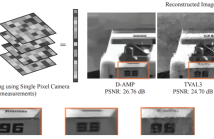- Transducers
- Spatial and Multichannel Audio
- Source Separation and Signal Enhancement
- Room Acoustics and Acoustic System Modeling
- Network Audio
- Audio for Multimedia
- Audio Processing Systems
- Audio Coding
- Audio Analysis and Synthesis
- Active Noise Control
- Auditory Modeling and Hearing Aids
- Bioacoustics and Medical Acoustics
- Music Signal Processing
- Loudspeaker and Microphone Array Signal Processing
- Echo Cancellation
- Content-Based Audio Processing

- Read more about Performance Evaluation of Beacons for Indoor Localization in Smart Buildings
- Log in to post comments
- Categories:
 12 Views
12 Views- Read more about Recognition of Spoofed Voice Using Convolutional Neural Networks
- Log in to post comments
- Categories:
 11 Views
11 Views
Reconstruction of signals from compressively sensed measurements is an ill-posed problem. In this paper, we leverage the recurrent generative model, RIDE, as an image prior for compressive image reconstruction. Recurrent networks can model long-range dependencies in images and hence are suitable to handle global multiplexing in reconstruction from compressive imaging. We perform MAP inference with RIDE using back-propagation to the inputs and projected gradient method. We propose an entropy thresholding based approach for preserving texture in images well.
- Categories:
 11 Views
11 Views- Read more about Multi-Glimpse LSTM with Color-Depth Feature Fusion for Human Detection
- Log in to post comments
With the development of depth cameras such as Kinect and Intel Realsense, RGB-D based human detection receives continuous research attention due to its usage in a variety of applications. In this paper, we propose a new Multi-Glimpse LSTM (MG-LSTM) network, in which multi-scale contextual information is sequentially integrated to promote the human detection performance. Furthermore, we propose a feature fusion strategy based on our MG-LSTM network to better incorporate the RGB and depth information.
ICIP_ORAL.pdf
- Categories:
 5 Views
5 Views- Read more about DEFORMATION TRANSFER OF 3D HUMAN SHAPES AND POSES ON MANIFOLDS
- Log in to post comments
- Categories:
 3 Views
3 Views- Read more about DEFORMATION TRANSFER OF 3D HUMAN SHAPES AND POSES ON MANIFOLDS
- Log in to post comments
- Categories:
 8 Views
8 Views- Read more about Deep Joint Discriminative Learning for Vehicle Re-identification and Retrieval
- Log in to post comments
In this paper, we propose a novel vehicle re-identification method based on a Deep Joint Discriminative Learning (DJDL) model, which utilizes a deep convolutional network to effectively extract discriminative representations for vehicle images. To exploit properties and relationship among samples in different views, we design a unified framework to combine several different tasks efficiently, including identification, attribute recognition, verification and triplet tasks. The whole network is optimized jointly via a specific batch composition design.
- Categories:
 21 Views
21 Views- Read more about Supervised Evaluation of the Quality of BinaryPartition Trees based on Uncertain Semantic Ground-Truth for Image Segmentation Purpose
- Log in to post comments
The binary partition tree (BPT) is a hierarchical data-structure that
models the content of an image in a multiscale way. In particular,
a cut of the BPT of an image provides a segmentation, as a partition
of the image support. Actually, building a BPT allows for
dramatically reducing the search space for segmentation purposes,
based on intrinsic (image signal) and extrinsic (construction metric)
information. A large literature has been devoted to the construction
on such metrics, and the associated choice of criteria (spectral, spatial,
- Categories:
 11 Views
11 Views- Read more about DEEP LEARNING ARCHITECTURE FOR PEDESTRIAN 3-D LOCALIZATION AND TRACKING USING MULTIPLE CAMERAS
- Log in to post comments
- Categories:
 17 Views
17 Views